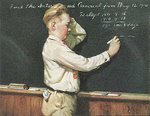
But really, who could compete with silky mitts such as these?
In "Student Blogging--What You Should Know," Sean Rahman of Michigan State University offers a series of tips for the nascent classroom blogger. Rahman notes that some college students will be asked by their teachers blog as part of their coursework, a pedagogical decision that Rahman sees as having many positive effects. Classroom blogs, he surmises, can offer opportunities for lateral learning, create additional means of communication between students and teachers, and "generally make writing more exciting for students." Stressing that classroom blogging is different from blogging in more informal contexts, Rahman lists a series of practical tips for the student blogger. Some of Rahman's suggestions range from urging the student to be aware of the opportunities and constraints of the technology (creating back-up files of all posts and allowing for computer mishaps are covered, for example), some deal with identity (blogging anonymously) and some with community (commenting on classmates' blogs).
Rahman's post trends toward the practical, and some of it could and does apply to using computers for any sort of composition; actually, if the students haven't been persuaded to budget for technical issue in their composing processes now, I doubt that this essay will inspire them to do so. The essay is hinting at being stronger when asking the reader to consider the importance of community in blogging, but Rahman again stays at a practical level, warning the student of half-hearted comments on others' blogs: comments such as "Try to put some "meat" into your post as well--many instructors won't give full credit for 'Me, too!' comments that don't contain any content" are important for students to read, but they shed no light for the student on just why thoughtful comments are integral to the communication found in blogs.
And perhaps this is my hang-up, that in fact the more theoretical sort of explanation is better left to another article. However, I really do think that Rahman misses an opportunity for real edification, having raised the specter of the importance of comments. Why settle for what amounts to a fleshed out checklist in an article that purports to offer students what they "should know" about blogging? Why not explain to them that this is a different genre of writing that has its own rules and context, different indeed from the essays students are normally assigned in class? Why not talk about the importance of design, images, and hyperlinks? I mean, besides their rhetorical value, aren't these part of the package that can cause blogging to be a type of writing that is "more exciting for students"?
Alas, space is apparently limited in Rahman's post, and thus it shall be here. Perhaps it was the author's goal to just provide some practical tips, so in fact, the title of the post is the only clear flaw. I wonder if I ask my students to create a similar list to Rahman's, what they might produce. Most likely, they will have written about a host of things neither me nor Rahman have considered. Yes, perhaps it's time for a little student-to-teacher learning.










No comments:
Post a Comment